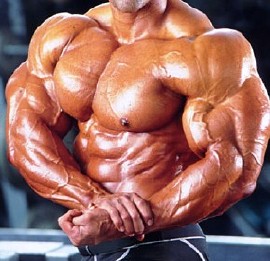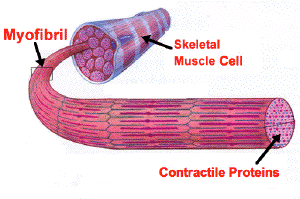|
By exploring how and why exercise causes muscles to grow,
scientists hope to help astronauts avoid muscle atrophy.
by Patrick L. Barry
Most machines don't
improve with use. Old pickup trucks don't gradually become Ferraris
just by driving them fast, and a pocket calculator won't change
into a supercomputer by crunching lots of numbers .
The human body is different.
As weightlifters know, the more that people use their muscles, the
stronger they become. And unused muscles do not remain preserved;
neglect causes them to waste away, or atrophy.
It's a remarkable response,
one that scientists don't fully understand. Somehow, muscle cells
"sense" how they're being used and then remodel themselves
to better fit the task. How does this happen? And what exactly is
it about exercise that triggers the changes?
NASA needs to know
the answers. Astronauts in space exercise furiously to keep fit.
Even so, their muscles tend to weaken.
"Normally, people's
muscles do a lot of work that they're hardly aware of - lifting
their bodies and maintaining posture against gravity. In space,
that constant muscular work is removed. There's a danger of atrophy,"
explains Kenneth Baldwin, a professor in the Department of Physiology
and Biophysics at the University of California, Irvine.

Heavy
use doesn't wear muscles out; instead they grow bigger
and stronger.
|
With NASA support,
Baldwin is researching the inner workings of muscles and plumbing
the fundamental mystery: Why do workouts work?
NASA has a special
interest in isometric exercises - i.e., non-moving exercises where
an astronaut pushes hard against a fixed surface. Motionless exercises
allow for simple lightweight equipment less expensive to launch
and less prone to break during a mission. But are they effective?
To find out, Baldwin's
group gave laboratory rats a workout by activating the rodents'
leg muscles with painless electrical stimulation. They tested three
types of exercise: muscle contraction, muscle lengthening, and isometric,
where the muscle exerts a force while remaining the same length.
(Just think of doing push-ups: muscle contraction occurs in the
"up" part of a push-up, muscle lengthening during the
"down" part, and isometric while holding a push-up midway.)
After the sessions,
the scientists performed tests to see how the rats' muscles responded.
"What we found," says Baldwin, "was that after 12
sessions, all three types of workout tended to provide about the
same amount of muscle growth," even the isometric exercises
that involved no motion.
This was nothing new.
Other scientists had come to the same conclusions before. But Baldwin's
group took their analysis a step further:

Each
muscle cell contains many small bundles of contractile
proteins, called myofibrils. These contractile proteins
do the work of muscle contraction.
|
In addition to measuring overall muscle
mass - how "buff" were the rats? - they also measured
the amount of contractile proteins within the muscle cells. Contractile
proteins are what actually cause a muscle to contract. They are
what give a muscle its strength.
To their surprise,
Baldwin's team found that while isometric exercises did prevent
leg muscles from withering, they did not stop a decline
in the amount of contractile proteins in those muscles. The muscle
was actually degrading on the molecular level.
No one knows why this
is so, but one thing seems clear: Isometric exercise might not be
the best way to maintain astronaut muscles. Baldwin plans to investigate
further with just-renewed funding from NASA.
A more unconventional
possibility is that astronauts could stave off muscle atrophy by
taking a pill. Anti-atrophy pills are only speculative right now,
Baldwin says, but there are reasons to believe that they might be
possible. That's because when atrophy sets in, the muscle isn't
just withering away passively - it's actively breaking itself down!
A complex network of
enzymes within the muscle's cells disassembles muscle proteins molecule
by molecule. "In order to chop those proteins up, you use a
lot of energy," notes Baldwin. If scientists could pinpoint
a key "lynchpin" enzyme in this network, they may be able
to design a drug to block its action, thus slowing the breakdown
of the muscle.

Astronaut
Peggy Whitson works out onboard the International Space
Station
|
This active breakdown
of muscle protein is going on all the time in everybody's muscles,
as is the constant assembly of new proteins. Whether a muscle grows,
shrinks, or stays the same size depends on the balance between these
rates of destruction and construction, a bit like the water level
in a bathtub that's both filling and draining at the same time.
Baldwin is taking a
look at the mechanisms behind the "construction" half
of this balance. In particular, his group is focusing on a hormone
called Insulin-like Growth Factor 1 (IGF-1). Muscles produce IGF-1
in response to strenuous exercise, and this hormone in turn activates
enzymes in the muscle cells that cause the cells to grow. Indeed,
Baldwin found that levels of IGF-1 in the rats' muscles were higher
just after exercising.
"Some people think
that it's the mechanical stress that turns the gene (for IGF-1)
on, but we really don't understand that process yet. What we do
know is that IGF-1 triggers muscle growth," Baldwin explains.
Might supplements of
IGF-1 be used to ensure that construction of muscle proteins keeps
pace with protein destruction in astronauts? Baldwin says they're
entertaining the idea and are already discussing ways in which that
might be done.
If they're successful,
it will be good news for more than just astronauts. After all, we're
all owners of that incredible, self-adapting machine called the
human body.
|
